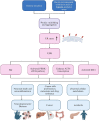Endoplasmic reticulum stress and therapeutic strategies in metabolic, neurodegenerative diseases and cancer
- PMID: 38509524
- PMCID: PMC10956371
- DOI: 10.1186/s10020-024-00808-9
Endoplasmic reticulum stress and therapeutic strategies in metabolic, neurodegenerative diseases and cancer
Abstract
The accumulation of unfolded or misfolded proteins within the endoplasmic reticulum (ER), due to genetic determinants and extrinsic environmental factors, leads to endoplasmic reticulum stress (ER stress). As ER stress ensues, the unfolded protein response (UPR), comprising three signaling pathways-inositol-requiring enzyme 1, protein kinase R-like endoplasmic reticulum kinase, and activating transcription factor 6 promptly activates to enhance the ER's protein-folding capacity and restore ER homeostasis. However, prolonged ER stress levels propels the UPR towards cellular demise and the subsequent inflammatory cascade, contributing to the development of human diseases, including cancer, neurodegenerative disorders, and diabetes. Notably, increased expression of all three UPR signaling pathways has been observed in these pathologies, and reduction in signaling molecule expression correlates with decreased proliferation of disease-associated target cells. Consequently, therapeutic strategies targeting ER stress-related interventions have attracted significant research interest. In this review, we elucidate the critical role of ER stress in cancer, metabolic, and neurodegenerative diseases, offering novel therapeutic approaches for these conditions.
Keywords: Cancer; Endoplasmic reticulum stress; Metabolic; Neurodegenerative diseases; Signaling pathway; Therapeutic strategies.
© 2024. The Author(s).
Conflict of interest statement
The authors declare that they have no competing interests.
Figures


Similar articles
-
Mechanisms of disordered neurodegenerative function: concepts and facts about the different roles of the protein kinase RNA-like endoplasmic reticulum kinase (PERK).Rev Neurosci. 2018 Jun 27;29(4):387-415. doi: 10.1515/revneuro-2017-0071. Rev Neurosci. 2018. PMID: 29303785 Review.
-
Endoplasmic reticulum stress and its role in various neurodegenerative diseases.Brain Res. 2024 Mar 1;1826:148742. doi: 10.1016/j.brainres.2023.148742. Epub 2023 Dec 29. Brain Res. 2024. PMID: 38159591 Review.
-
The role of endoplasmic reticulum stress in neurodegenerative disease.Apoptosis. 2017 Jan;22(1):1-26. doi: 10.1007/s10495-016-1296-4. Apoptosis. 2017. PMID: 27815720 Review.
-
Hidden Agenda - The Involvement of Endoplasmic Reticulum Stress and Unfolded Protein Response in Inflammation-Induced Muscle Wasting.Front Immunol. 2022 May 9;13:878755. doi: 10.3389/fimmu.2022.878755. eCollection 2022. Front Immunol. 2022. PMID: 35615361 Free PMC article. Review.
-
The Role of Endoplasmic Reticulum Stress in Metabolic Diseases.Metab Syndr Relat Disord. 2024 Sep;22(7):487-493. doi: 10.1089/met.2024.0013. Epub 2024 Apr 26. Metab Syndr Relat Disord. 2024. PMID: 38666441 Review.
Cited by
-
Endothelial Unfolded Protein Response-Mediated Cytoskeletal Effects.Cell Biochem Funct. 2024 Dec;42(8):e70007. doi: 10.1002/cbf.70007. Cell Biochem Funct. 2024. PMID: 39449673 Review.
-
Cellular Distribution and Ultrastructural Changes in HaCaT Cells, Induced by Podophyllotoxin and Its Novel Fluorescent Derivative, Supported by the Molecular Docking Studies.Int J Mol Sci. 2024 May 29;25(11):5948. doi: 10.3390/ijms25115948. Int J Mol Sci. 2024. PMID: 38892135 Free PMC article.
-
Lysosomal Storage-Independent Fabry Disease Variants with α-Galactosidase A Misprocessing-Induced ER Stress and the Unfolded Protein Response.Nephron. 2025 Mar 20:1-11. doi: 10.1159/000545388. Online ahead of print. Nephron. 2025. PMID: 40112790 Free PMC article. Review.
-
Endoplasmic reticulum stress-related genes contribute to lung cancer risk: a multiomics data integration study.Transl Lung Cancer Res. 2025 Jun 30;14(6):2210-2226. doi: 10.21037/tlcr-2025-474. Epub 2025 Jun 26. Transl Lung Cancer Res. 2025. PMID: 40673098 Free PMC article.
-
A Narrative Review of Prognostic Gene Signatures in Oral Squamous Cell Carcinoma Using LASSO Cox Regression.Biomedicines. 2025 Jan 8;13(1):134. doi: 10.3390/biomedicines13010134. Biomedicines. 2025. PMID: 39857718 Free PMC article. Review.
References
-
- Abisambra JF, Jinwal UK, Blair LJ, O’Leary JC, Li Q, Brady S, Wang L, Guidi CE, Zhang B, Nordhues BA, et al. Tau accumulation activates the unfolded protein response by impairing endoplasmic reticulum-associated degradation. J Neurosci. 2013;33(22):9498–507. doi: 10.1523/JNEUROSCI.5397-12.2013. - DOI - PMC - PubMed
-
- Auf G, Jabouille A, Guerit S, Pineau R, Delugin M, Bouchecareilh M, Magnin N, Favereaux A, Maitre M, Gaiser T, et al. Inositol-requiring enzyme 1alpha is a key regulator of angiogenesis and invasion in malignant glioma. Proc Natl Acad Sci U S A. 2010;107(35):15553–8. doi: 10.1073/pnas.0914072107. - DOI - PMC - PubMed
Publication types
MeSH terms
Grants and funding
LinkOut - more resources
Full Text Sources
Medical
Research Materials

